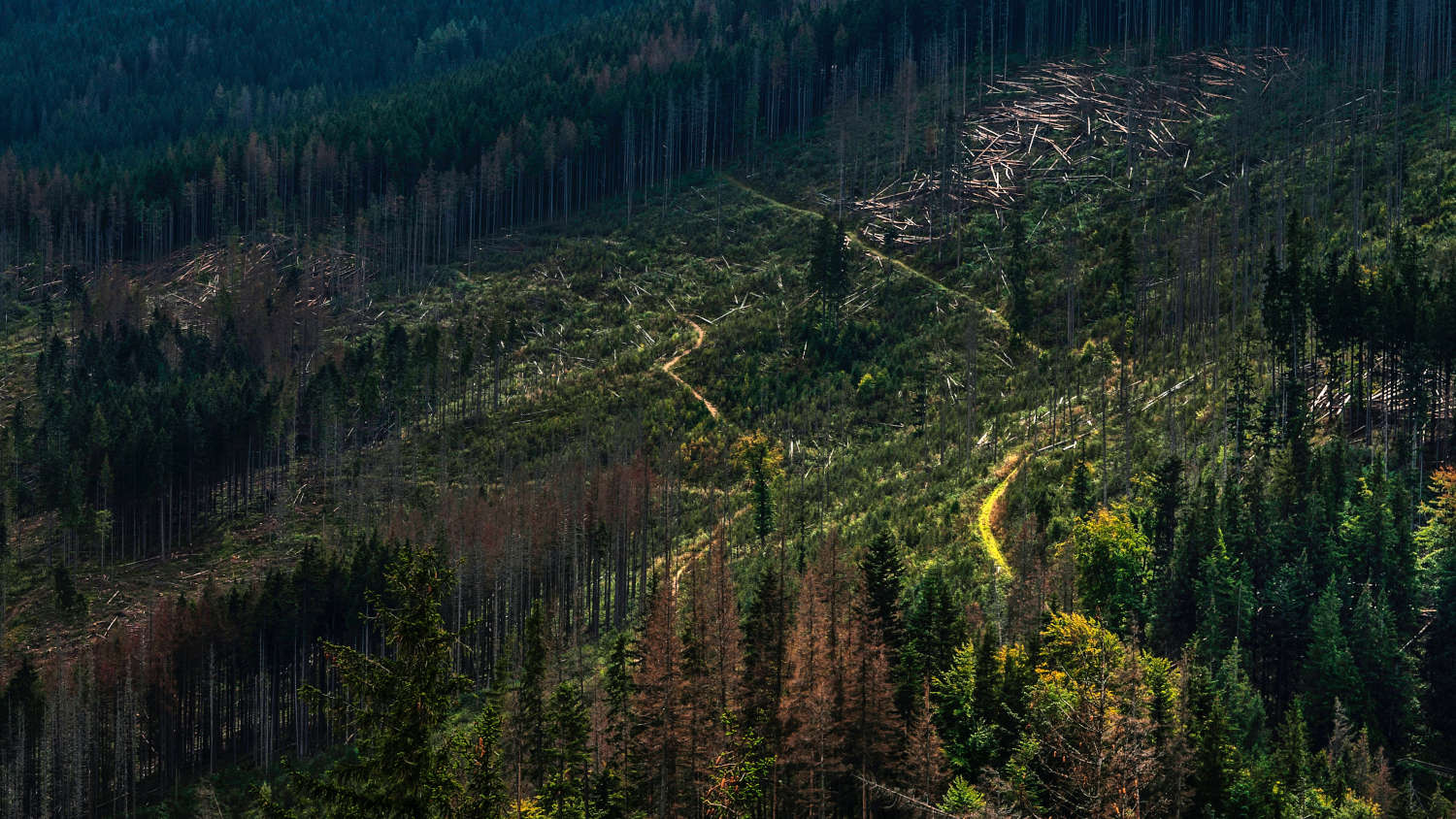
Did you know that forests cover more than 30% of the Earth’s land surface?
Forests are a big source of food, medicine, and fuel for more than a billion people. In addition, 13.4 million people have jobs in the forest sector, and another 41 million people have various jobs related to forests.
Unfortunately, the mass destruction of trees continues to rise by the day, risking the loss of all the benefits of trees, all for short-term gain.
According to The World Bank, about 3.9 million square miles of forest have been lost since the beginning of the 20th century.
As more and more people continue to pay attention to climate change, a lot of buzz has also been created around forest degradation. However, there’s still a lot of confusion about what deforestation really is — and why it matters.
In this guide, we break it down for you so you understand why deforestation is bad, and why it affects us all.
What is Deforestation?
Let’s start with defining what is deforestation.
Deforestation is the permanent removal of trees to create space for other economic gains such as agriculture, grazing, or using timber for fuel, construction or manufacturing.
The biggest reason why it occurs is farming. 80% of destruction of trees is believed to be a result of extensive cattle ranching, and logging for materials and development.
Cutting down trees has been happening for decades. Probably since humanity started converting from hunter/gatherer to agricultural-based societies. This destruction became a pandemic after the onset of the modern era.
Deforestation can occur in any area densely populated by trees and other plant life. The majority of it, at the moment, is happening in the Amazon rainforest. Around 17% of the Amazon forest has been lost in the last 50 years, mostly to make room for cattle ranching.
According to a 2017 report by scientists at the University of Maryland, tropical areas near the Equator lost about 61,000 square miles of forest in 2017. This is an area the size of Bangladesh.
Read more: Sustainable Facts
What is Driving Deforestation?
While forest degradation has continued to become a menace, it is no surprise that the main drivers are common commodities that we all come across daily.
At least three-quarters of forest loss is driven by agriculture. People are clearing forests to grow crops, raise livestock and produce wood products such as paper and timber.
Just four commodities—beef, soy, palm oil, and wood products—drive the majority of tropical deforestation. Out of these four, Beef, soy, and palm oil are responsible for 60% of forest cover loss in tropical forests in the world.
1. Beef
People are increasingly cutting down trees to make more room to raise cattle to produce beef. This habit has caused 41% of forest degradation. That’s 2.1 million hectares every year – which is about half the size of the Netherlands.
Read article: What Is Intensive Agriculture?
2. Palm oil
Palm and soy seeds, often categorized as oilseeds, drove 18% of forest loss in tropical forests. Production of palm oil in Indonesia takes the lead in this destruction followed by Malaysia.
3. Soybean
The higher the demand for beef the higher the demand for soybean. Every year around 480,000 hectares are deforested for soy in major soy-producing tropical countries. Soy is mainly used to feed pork, poultry, and dairy cows. A significant amount is also used to produce vegetable oil and biodiesel. Latin America has large fields of soybean fields that are created from newly deforested land.
4. Wood products
Wood products can be divided into two categories; pulp and timber. Pulp is made from tree fibers and used to produce paper and related products. Timber, on the other hand, is used for construction and making furniture. High demand for wood products has seen countries convert primary forests to tree plantations. This has also increased logging leading to the loss of forests.
5. Other drivers
Other commodities that are also driving forest degradation include coffee, rubber, cocoa, and sugar. Infrastructure and extractive activities, such as the expansion of mining, have also increasingly become important drivers to take note of.
Why is Deforestation Bad?
Forest destruction is a crisis for the whole planet and the sad truth is that this crisis affects us all, whether we realize it or not. Every every two seconds a chunk of forest the size of a football pitch is destroyed every single day.
Current destruction is so high that there’s only about half the number of trees in the world today than there were when humans first evolved. The fastest rate of forest destruction has been in the past couple of centuries.
As well as being stunningly beautiful, forests are vital for the health of our planet and when they are destroyed, plenty of consequences follow. There are myriad effects of deforestation including climate change, soil erosion, flooding, desertification, and more.
Let’s take a deeper look at some of the top consequences of deforestation:
Soil erosion
One of the effects of deforestation on the environment is soil erosion. Trees bind soil firmly on the ground and when they are cut down, the soil erodes and washes away. This then leads to farming issues, clogged waterways, mudslides, and beyond. If this land is left bare, it becomes more susceptible to flooding, specifically in coastal regions.
Disruption of the water cycle
Trees cause water evaporation then release the evaporated water into the atmosphere via extracted groundwater, then it rains, reinvigorates the area, and the cycle continues. But if there are no trees, there will be no water cycle. And this will lead to desertification, leaving the land dry and at-risk for fire and loss of plants and wildlife.
Additionally, three-quarters of the Earth’s freshwater comes from forested watersheds. Without trees, the quality and quantity of water safe for drinking will be depleted.
Emission of greenhouse gases
Trees absorb a huge amount of harmful greenhouse gases such as carbon dioxide and methane. They store it in their trunks and leaves. If there are no trees, then these gases will stay in the air. Deforestation is responsible for 30 percent of global greenhouse gas emissions annually.
Loss of biodiversity
Loss of biodiversity is probably one of the most heartbreaking reasons why deforestation is bad. 70% of land animals and plant species live in forests. Deforestation is a threat to known and unknown species that might die as a result of the loss of their habitat. And when one species dies, others that are reliant on their existence are also affected, creating a chain effect.
The World’s Most Threatened Forests
There are hundreds of countries around the world that are home to some of the world’s most species-rich, culturally significant, and stunningly beautiful forests. Unfortunately, some of these gorgeous forests are hotspots and at risk of being extinct in 15 years if we don’t do more to save them.
The Amazon
The Amazon in South America is the world’s largest forest. It is also the forest that has undergone the most destruction. The major drivers of degradation at the Amazon are cattle ranching and agriculture. It is believed that over one-quarter of the forest will be without trees if destruction continues.
Greater Mekong
The Mekong continues to be converted for sugar, rice, rubber, and biofuels to cater to the rising population in the region.
Atlantic Forest
The Atlantic forest spans parts of Paraguay, Brazil, and Argentina. This forest is one of the richest rainforests in the world. It is also where 75 percent of the Brazilian population lives putting a lot of pressure on the forest due to human activities.
Borneo Forest
Only 33 percent of the Borneo rainforest is currently remaining. Degradation in this forest is driven by palm oil plantations.
Eastern Australia
Forests in the states of Queensland and New South Wales continue to get depleted to create pasture for livestock.
Congo Basin
The Congo basin contains 20 percent of the world’s tropical forests and the highest biological diversity in Africa. The forest is quite close to the urban centres placing it at risk especially since the human population here is expected to double by 2030.
Forests in Eastern Africa
Most forests in Eastern Africa are over harvested for timber and fuelwood, illegally logged, or converted for livestock and cash crops. Only 10 percent of the coastal forests of Tanzania and Kenya are standing.
New Guinea
New Guinea and its neighboring islands are home to the largest remaining tracts of tropical forest in the Asia-Pacific region. Agriculture, however, remains a great threat to this forest.
Sumatra
Riau province in Sumatra is the center of Indonesia’s palm oil production driving deforestation, even in protected forests and national parks.
How Does Deforestation Affect Humans?
Humans, though unaware, suffer the most from their destructive behavior of cutting down trees.
Destruction of homelands
Deforestation is a threat to 200 million people who have homes in forests and an additional 1.4 billion people who depend directly on forest goods for their survival. Indigenous communities who live in and depend on forests for their livelihood are under threat as large amounts of forests are cleared away.
Food shortage
Forest destruction leads to climate change which then leads to altered weather patterns characterized by the extreme heat or too much rainfall. Such weather patterns and environmental changes cause low agricultural produce leaving people suffering from food shortage.
Harsh weather conditions
With climate change comes extreme weather conditions such as the intense heat or extreme rainfalls. Such conditions lead to the emergence of various health problems that may lead to death.
Floods
When we cut down trees, the soil erodes and washes away, causing farmers to move on leaving the land barren. Such land then becomes more susceptible to flooding causing deaths or displacement of people.
Related article: Living sustainably
Consequences of Deforestation: What Will Happen If It Continues?
Amost 15 billion trees are cut down every year around the world. This comes with dire consequences for wildlife, people, and the climate. As the forests shrink, the planet suffers from wide-reaching problems, including soil erosion, water cycle disruption, greenhouse gas emissions and biodiversity losses.
- Loss of animal and plant life: If deforestation is not curbed, 80 percent of Earth’s land animals and plants that live in forests such as the orangutan, Sumatran tiger, and many species of birds, will become extinct.
- Water cycle disruption: If forest cover loss continues there will be less rain and hence our freshwater sources will continue to get depleted increasing the water problems the world is already grappling with.
- Increased soil erosion: Continued loss of trees will lead to increased soil erosion. This will then see an increased rate of landslides around the world.
- Flooding and drought: When forest cover is lost, fooding is highly likely to occur especially during the rainy season. During the dry season, areas with high levels of forest destruction can suffer months-long droughts.
- Increased greenhouse gas emissions: Carbon dioxide and methane trap heat in the atmosphere, leading to global climate change. Trees release oxygen and water into the atmosphere and absorb carbon dioxide hence cleaning the air. So the more we continue to cut trees down, the more greenhouse gases will be released into the atmosphere.
Forests in addition to their numerous value to animals and man, are also uniquely valuable just by their very nature as forests. We risk losing all of it as we allow forest degradation to continue.
Stopping this harmful practice now is much more strategic and cost-effective than waiting to deal with the far-reaching consequences later.
You Might Also Like:
Stella is a writer and mother from Thika, Kenya. Her love for nature and the beautiful Kenyan outdoors has inspired Stella to consciously make an effort to lead a more sustainable, eco-friendly lifestyle.
![]() Stella - Writer
Stella - Writer


